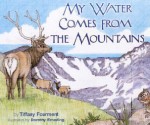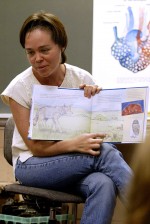New LTER Book teaches Ecological Literacy to Children
Outreach efforts at the Niwot Ridge (NWT) LTER site in Colorado – the only LTER site in an alpine tundra environment – have inspired a children’s book about the water cycle. My Water Comes from the Mountains explores the ecosystems along Boulder Creek as snowmelt flows through the mountains, becomes the water supply for the City of Boulder, and moves into prairie habitats as the irrigation supply for farmers, plants, and animals.
The author, Tiffany Fourment, began this project while participating in the Schoolyard LTER program at Niwot Ridge. NSF funding supported production of the book and enabled its distribution to local elementary schools. The Institute of Arctic and Alpine Research (INSTAAR) of the University of Colorado, which oversees the Niwot Ridge site, distributed the book to local elementary schools in May 2004—a requirement of the contract between NWT and the publishers.
Ms. Fourment is an environmental educator who took the course "Alpine Ecology and Experiential Learning" taught at the Niwot Ridge LTER site. The course is held each summer for in-service and pre-service teachers. For three weeks, teachers learn alpine ecology in a field setting, lead field trips of children from local K-8 programs, and create curriculum projects they can use in their own classrooms.
My Water Comes from the Mountains began as Fourment’s final project for the alpine ecology course. She completed the material after teaching third grade students about the Boulder watershed the following year. Dorothy Emerling, a well-known children’s book illustrator who lives just a few miles from Niwot Ridge, illustrated the text with scenes of animals and habitats found along the creek. She got plenty of help from Ms. Fourment’s third graders, who contributed drawings and their impressions of the field site. Roberts Rhinehart signed on as publisher.
Designed for third to fifth grade students, My Water Comes From The Mountains is consistent with the science standards for those grades. Its strengths include its focus on the local environment and its integration of material on natural and human-influenced systems. Diane McKnight, the INSTAAR fellow and professor of civil, environmental and architectural engineering at the University of Colorado who conducts the alpine ecology course, said: “We feel it’s important to help local children understand the connection between the lives they lead and the alpine tundra.”
The process of preparing the book involved extensive consultation with the City of Boulder Water Department, and it can be used in the classroom in conjunction with materials available through their K-12 outreach program. Graduate students affiliated with INSTAAR distributed classroom sets of the book to every elementary school in the Boulder Valley and St. Vrain Valley school districts. The book will also be sold in bookstores and U.S. National Park stores.
Another children’s book, The Lost Seal, is already in the works at the Antarctic LTER site. It focuses on the harsh environment of the McMurdo Dry Valleys through a story about researchers’ encounter with a live seal in 1992. Currently, the LTER Network (through the efforts of McKnight), NSF, and Roberts Rhinehart, are exploring the possibilities for a series of children’s books inspired by LTER work.
Shelly Sommer
Outreach Coordinator, Information Center, Institute of Arctic and Alpine Research (INSTAAR), University of Colorado at Boulder
and
Michelle Kelleher, BIO/DEB Science Assistant, National Science Foundation (NSF)

 Enlarge this image
Enlarge this image
